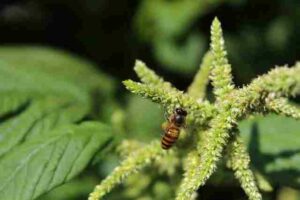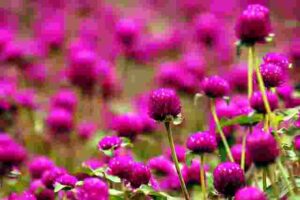If you are searching for the amaranth flowers? Before that let me tell you it’s a beautiful flower that comes in different colors.
Amaranth is a unique flowering plant with a dangling-like appearance that is popular due to its importance in healing in Greek mythology. Amaranth in the bible is said to be pure and the Jesus Christ used it as a food grain. The word amaranth means “everlasting” which is definitely true as they do not fade after wilting. It is used as a food crop and its benefits include complete protein with proper amino acid.
Amaranth Flower Meaning
Amaranth flower meaning and symbolism is immortality, love, affection, fondness and charm. It is hard to understand the true meaning of this flower, but many believe it also represents everlasting blossoms because they are perennial flowering plants. As a gift it can tell the other person about your positive gesture, friendship, care and beauty inside of your heart.
It is used at wedding time to convey a message by the partner about their relationship and love will last forever. The plant has a good characteristic that it never fades and keeps on flowering just like how people have thought about it as an everlasting beautiful bloom. In ancient times the plant is said to have healing properties and after a few years in study on animals it is known to relieve some of the problems like diarrhea, High cholesterol, swelling and ulcer. It contains antioxidants that reduce inflammation but there is no proof that it can be helpful in humans according to Webmd.
Amaranth flower symbolism

Amaranth flower is a symbol of beauty, immortality, everlasting, never ending life, or long-lasting love. Amaranth can be fitted for almost any garden. They are both perennial and annual growing ornamental plants. There are different meanings connected to this plant. Amaranth flower means unending life, beauty and immortality due to its never fading blossom.
It is used as a food crop and can have the ability to heal a few problems but only tested in animals. Amaranthus requires an area with full sunlight but you can also grow it indoors with partial shade. A good organic compost based potting soil will be best suited for this flower.
The Amaranth flower also likes warm places and if you are growing it then it can be grown from seeds which need moisture in initial days to grow. I have grown it to full so for the germination process watering is important. Do not grow them in winter frost as it can damage the seed easily.
Amaranth flower is used in different cultures to signify revival, rebirth, pureness and immortality. The flower is not only long lasting but strong which makes it also being associated in bible with virgin Mary as her name also means strong, pure and beautiful.
Amaranth flower colors

Amaranth flower colors include Red, green, blue, pink, purple, and orange. The amaranth plant’s most common flower color is reddish and they grow as annuals & can make your garden bed more beautiful and you can also grow it in containers as well. The Fat-Spike variety is actually in purplish to red shades while the golden giant has yellowish blooms. They are low maintenance plants and generally show up in the fall or summer season. The plant has a height of 2-3 feet while it spreads to 3 feet wide.
Amaranth flower language

Amaranth flower language meaning is changeless, everlasting, unfading emotion or affection towards People. Amaranth flower is derived from the Greek word amaranths which is a symbol of long-lasting immortality. It also means beauty, royalty, ambition and wealth. They are also gifted so that the receiver gets good fortune and a happy life.
Amaranth flower tea

Globe amaranth tea is basically a magical tea that is beneficial for heart due to its magnesium property. It also contains Vitamin, minerals that can help with a lot of problems including skin, collagen, muscle fatigue, lower the Blood pressure and helps to process the iron because it contains vitamin C as well. Leaves of amaranth have amino acid called lysine that helps in absorption of calcium. They contain a good amount of phosphorus, fiber, and protein in it, which is a requirement of the body for energy production. Some call it superfood while others feel that this herbal tea can relieve different problems by providing a lot of vitamins like vitamin K, folate, vitamin A and so on.

Amaranth flower seeds
Amaranth flower seeds are the best way to propagate its purplish plant. They are priced at $2 to $30 in some stores. There are also some of the varieties which are sold at higher price for its benefits.
Buy Quality Seeds from Here – Shop Now
Link 2 – Shop from Amazon
Amaranth flower tattoos
The Amaranth flower tattoo is a symbol of immortality and eternal life. The amaranth flower has cultural importance because it never dies even after wilting. This tattoos symbolism tells about the flowers ability to grow & tolerate different climate conditions. The plant is also associated with strength, kindness, nutrition, endurance, passion, beauty and healing.
Most amaranth tattoos can be different in various cultures but yes how they never fade make it more strong and hopeful. These flowers tell us about the world, nature and how they are coexisting with each other and no one is alone.
Amaranth flower edible
Particularly a red amaranth flower which is good as a food source because its stalks, seeds, flowers, stems is edible. They are packed with protein and other nutritional benefits that can help in building bones and giving your body antioxidants to protect from inside. Red amaranth flower is a rare variety that is used as a superfood. But the amaranth originally used to have healing properties to solve various problems.
Amaranth flower benefits
Amaranth flower has medicinal benefits which comes from seeds that can be eaten as it provides protein. Lysine is an amino acid which is provided by this crop which has more than thirty percent of protein than other edible crops like rice and rye.
These plants can tolerate different climate conditions. They are everlasting blooms and they do provide benefits which can lower cholesterol level in the body but the study is limited and the researches do not have complete information about this flower seeds.
They do make a good houseplant and they were grown as a food crop in ancient times.
Is amaranth flower poisonous?
Yes, amaranth(Pig weed) can be poisonous due to oxalates & other unidentified compounds can be harmful. Soluble oxalates can merge with the calcium in blood which results in insoluble calcium oxalates. These are then filtered by the kidney but then it gives problems like oxalate nephrosis. This problem occurs when the amount of oxalates are higher but there is a lack of enzymes that break the oxalates, it causes this issue and may end up kidney failure as well.
What is the Cultural Significance of an Amaranth Flower?
Amaranth flowers are special in many cultures because amaranth flowers seeds are used to mix with honey to create a statue of Aztec god Huitzilopochtli. The Aztec festival is celebrated during the month of winters between 7 to 26 December.
It is also called the Aztec(Mexican calendar) month of Panquetzaliztli , where people decorate their homes, enjoy the month with dancing, and do rituals. Also as many religions follow the practice of fasting, here the people in the Aztec festival do fasting or eat very less.
They also make a statue of god with amaranth seeds that is why it has great importance for cultural aspects. After the festive month, people enjoys the food as it that is made from the seeds and honey.
Aztec people come from different ethnic groups and it is a culture that belongs to central Mexico. Amaranth flower is associated with immortality because the blooms of it never wilt or die back and it is also known by the name love lies bleeding.
Another link to Amaranth flowers is with Greek myths and at that time no one knows about that flower.
Also Read:
15 Popular House Plants With Orange Flowers – Indoor Flowering
26 Popular Flowers that Start with H – Beginning Letter(With Pictures)
Sources
https://s3.wp.wsu.edu/uploads/sites/2073/2014/03/091412.pdf
https://csuvth.colostate.edu/poisonous_plants/Plants/Details/81
https://en.wikipedia.org/wiki/Amaranth
https://en.wikipedia.org/wiki/Aztecs
https://www.extension.iastate.edu/alternativeag/cropproduction/amaranth.html
